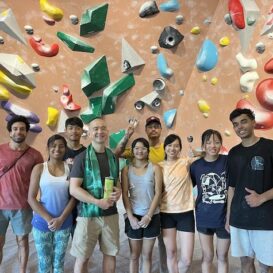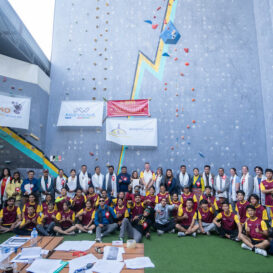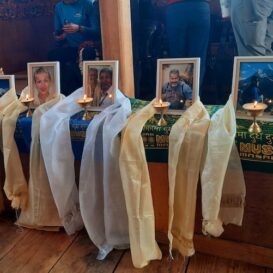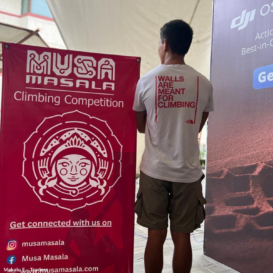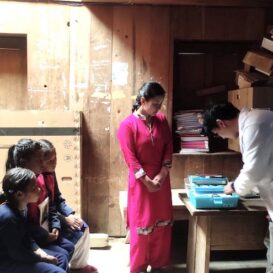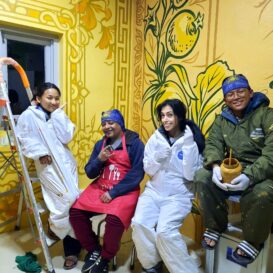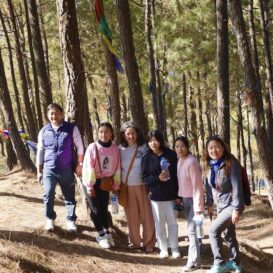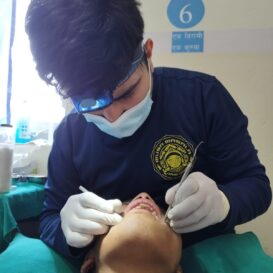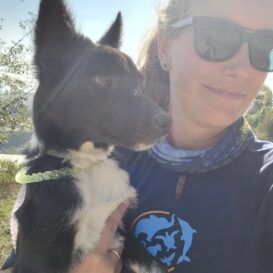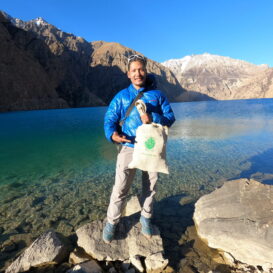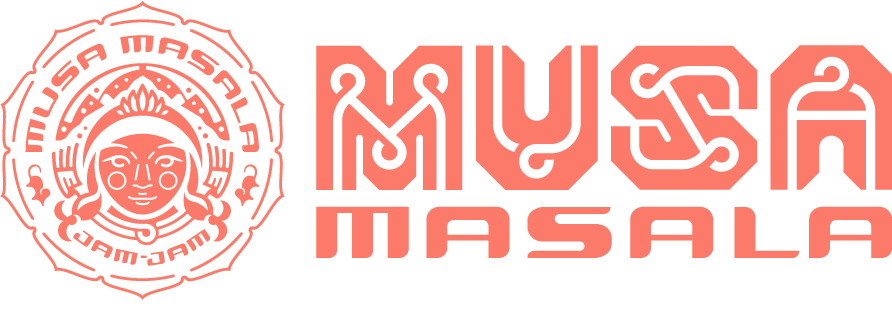After Musa Sarah Frances McClure put word out about our fundraiser art show for the Wongchu Sherpa Memorial Hospital, we were fortunate to get a response from Sapana Adhikari, offering to donate a piece. Her painting of a Nepali woman was so moving, it sold immediately. We’ve since gotten to know Sapana a bit more and wanted to share her story with all of you. She’s doing amazing work in Nepal, in addition to her work as an emergency room doctor.
Please check out her website at sapanaadhikari.com, where you can see the painting she donated to our auction. Learn more about her volunteer ventures at smartketi.com, and wecaresolar.org.
We’ll follow up with a story about Sapana and other team members with Team Rubicon in Nepal who stepped in to help after the earthquake of April 25th, 2015. Thank you so much for joining or efforts, Sapana. We want to support you in yours.
Tell us how you became involved with volunteering in Nepal.
As a Nepali-American, I have traveled to Nepal many times throughout my life, mainly to visit family in Kathmandu. In 1995, when I was in college, I spent a summer in a rural village, called Manthali, and volunteered at a health post. Although my medical knowledge was minimal at that time, I helped the staff distribute family planning medicines (Depo Provera) to the female villagers and helped the staff distribute oral rehydration therapy during a cholera outbreak. I connected to the kind people in this village. I felt a need to return to this village in the future. When I left, I made a promise to the hospital staff that I would one day return as a doctor to see what I could do to help this village. After I completed college, medical school and EM residency 19 years later, I returned to this village. I have been visiting Manthali on a yearly basis for the last four years.
You’ve been working on several projects in Nepal. Can you go through each and give us a quick rundown?
My main focus has been in Manthali, volunteering at Tamakoshi Cooperative Hospital. More recently, I have branched out to a more rural village called Bethan to help a more fledgling hospital get off the ground. While volunteering at the hospital, I have been involved with several projects. I arranged for an ACLS certified instructor to teach a CPR course to the staff. I coordinated with We Care Solar, a US-based charity, to donate and install two “Solar Suitcases” to the hospital. I coordinated with Americares, another US-based charity, and distributed much needed medical supplies to the hospital. (Dermabond for lacerations and Xeroform gauze for burns seem most helpful.)
I also spend time with the local community and have established a small women’s cooperative called smartket (translated to “smart girl”). The young girls make bracelets in Manthali that are then sold by volunteers in the US and UK. More recently, the bracelets are also being sold at local craft fairs, boutique stores and conventions. Proceeds from these sales go back to support several projects that smartketi runs. Projects include: funding a women-led, women-run start-up project that makes sweaters for local schools’ uniforms, establishing a “smart library” that brings English-speaking teacher volunteers to the local school, and donation of solar lamps to a neighboring school that does not have a reliable electricity source. (For more information, check out www.smartketi.com.)
In a rural hospital in Nepal such as the ones you are working at, what essentials seem to be the most needed?
In Manthali, I see mainly a rural, agriculture-based population of farmers and laborers. I treat several cases of COPD and burns, mainly stemming from the fact that women cook in unventilated, open-cook stoves. I treat several orthopedics injuries, like broken bones and lacerations from accidents in the rice and wheat fields. I treat a lot of chronic back pain and knee pain from years of hard physical labor. I treat patients with gastritis, mainly stemming from the dietary structure. I do see some interesting cases that are more unique to Nepal and infrequently seen in the US: hookworm infections, tetanus, organophosphate poisoning, [more] suicide attempts and cholera. The type of medicine I practiced is quite different, mainly because it is in a resource-limited setting. There are no specialists, no operating rooms, no CT scanners or MRI machines. Anything more serious is transferred to the capital, Kathmandu, a 4-6 hour bus ride away.
You deployed with Team Rubicon for the Nepal earthquake in 2015. We will do another in depth interview on this, but can you briefly describe what you found upon arrival?
I was the medical director with Team Rubicon’s deployment after the earthquake in 2015. As we were one of the first non-Nepali teams to arrive post-earthquake, we were very involved with the initial disaster relief effort. Team Rubicon had invaluable disaster experience and quickly mobilized several teams to set up mobile health camps that started treating patients right away. They were also instrumental in distributing supplies.
Tell us a bit about your future plans in Nepal.
I plan to continue visiting Nepal annually and volunteering in Manthali. I have been getting more involved with the local community, through smartketi, in an attempt to help them advance themselves. I hope to continue to network with various organizations and to try to coordinate donations of what is needed. I get immense enjoyment from my time in Nepal and hope to continue going frequently and invite anyone who may be interested in coming along!





